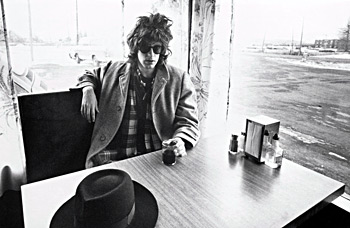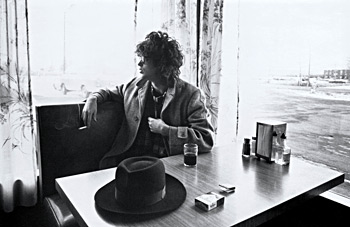RELEASES
IN A SPECIAL PLACE sleevenotes by Mike Scott

In the winter of 1984-5 I spent a couple of weeks in New York. One wild January day, when the wind charged like stampedes of wild horses down the mighty avenues, I walked down a narrow backstreet and discovered the most curious shop I'd ever seen. It was a witches' store, its shelves filled with potions, grimoires, scraps of wood, bark and root and numberless weird things I had no words or names for. And as I squinted around this dark space my eye was attracted by a massive, enigmatic-looking black-bound book. I drew it from the shelf and opened it to find it was full of blank white pages! Feeling like a character in a tale, I took the book to the store counter and asked the man standing there, a lantern-jawed fellow with an air of brusque authority, what it was for. He told me it was a "Book of Shadows" in which witches would write down spells, rituals and accounts of their experiences. I'd heard of such things, indeed, but like a lightbulb going off above my head, the idea struck me that this "book of shadows" was perfect for me to write my songs into. And lyrics, with their intent to enchant and transport the listener, were only another kind of spell anyway. What's more; the book's pages were so big I could write out each of my lyrics, including all possible verses and variations, plus musical and arrangement notes, on one two-leaf spread without having to turn the page.
So I bought the book and when I returned to my flat in London I gathered all my loose sheafs of paper, writing notebooks, jotters and pads and wrote into the Book every song I had in progress, forty or fifty in all, the repertoire for the third Waterboys album This Is The Sea.
The Black Book may only have been paper, cardboard and binding thread, but once it was filled with songs it became alive, a thing of power, the motherlode of my work. I only had to open it to enter the flow of my writing. And it accompanied me on every step of the making of This Is The Sea; spread open on the floor while I wrote in my Ladbroke Grove flat for hour after hour, next to me on the back seats of a hundred black cabs as I travelled to the studios of London through the spring of '85, laid open on the mixing desk, instructions displayed in my tiny hieroglyphic writing, while the album was honed, sculpted and ultimately finished.
This Is The Sea was a lavishly produced record, and journalists came to refer to its sound and style as "the big music", borrowing that name from a song on the previous Waterboys record A Pagan Place. But the first recordings for the album, in the early spring of 1985, were a series of simple piano/vocal demos. On the first day of the sessions I set the Black Book up on a studio piano and sang its contents down onto tape in order to review the songs and make selections as to which should be included on the record.

The studio was called Park Gates, a converted barn surrounded by trees in rolling English countryside. The recording room was a vast, high-raftered space with a spectacularly good grand piano in its centre. My co-producer John Brand set up a couple of microphones and got me a canyonesque reverberated vocal sound. We turned the lights down low and I sang everything in the Book.
This album, issued twenty-six years later, is a selection of those recordings, unadorned, exactly as they were made, canyonesque vocal sound and all. And between songs you can hear the unmistakable sound of me turning the pages of the Black Book, flicking through them till I alight on whichever song I felt like playing next.
The recordings include early versions of Be My Enemy, Don't Bang The Drum and The Pan Within, all with later-discarded lyrics, and an early run through of The Whole Of The Moon, again with unused lyrics and capturing the development of one of my best-known songs some months before its familiar "too high, too far, too soon" chorus was written.
And there are several songs and fragments that didn't make the final cut of This Is The Sea. The Woman In Me and Winter In The Blood are works-in-progress which I never completed as songs, though maybe I should. All The Bright Horses is a poem set to music which I considered inferior to the similarly short Spirit (one miniature poem-song on the final album was enough). The Day I Ran Out Of People - written after a dream - and Paris In The Rain - about the poet Rimbaud whose writings I'd discovered a year or so earlier - are complete songs which didn't quite measure up to the standard of the tracks chosen for the finished album. Custer's Blues, inexplicably left off the record - like all young artists I made decisions that twenty-five years later mystify me - was revived during the Fisherman's Blues sessions two years later. Looking For Dickon is the original lyric for what became Church Not Made With Hands on the Pagan Place album, and even during the birth of This Is The Sea I clearly hadn't finished experimenting with it.
Two extra tracks, piano-based but with more developed instrumentation, are included as extras. Old England is a demo made at Karl Wallinger's home studio the day it was written. I sing and play piano and lead guitars, while Karl supplies snare drum and synth bass. Trumpets is a 2011 remix by Don Jackson of the original album track, and features one of the best soundmixes I've ever heard of my voice. I include them as reminders of what's possible when the music is expanded from its pure beginnings, and as a contrast against which stands the starkness of the 13 piano/vocal tracks.
Photos by Patrick Durand

















